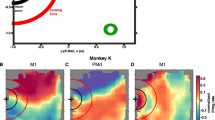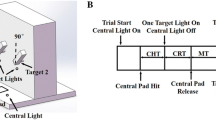Summary
Single cell activity was recorded from the putamen in rhesus monkeys (Macaca mulatta) performing limb movements made both with and without a preceding preparatory “set” concerning the impending direction of movement. The monkeys were trained to perform an elbow step-tracking task, each trial of which required the subject to make two sequential movements that were virtually identical in terms of their direction, amplitude, velocity and muscle pattern. The first movement was preceded by a foreperiod, the “pre-instruction” period, during which the monkey could not predict the direction (flexion/extension) of the forthcoming movement. The second movement was also preceded by a variable foreperiod, the “post-instruction” period, but during this interval the monkey was aware of the impending direction of movement because it was always required to match that of the first movement. To dissociate the directions of motor set (and limb movement) from the patterns of tonic (and phasic) muscular activation associated with task performance, some trials included the application of torque loads that either opposed or assisted the movements required by the behavioral paradigm. Two principal forms of task-related activity were observed among the 232 putamen neurons (all located within the region of arm representation) whose discharge patterns showed significant relations to one or more features of the behavioral paradigm. “Movement-related” neurons (178/232, 76.7%) discharged selectively in association with either flexion or extension movements of the elbow. “Set-related” neurons (47/232, 20.3%) manifested sustained, selective changes in discharge throughout the post-instruction period, while the monkey was required to maintain a preparatory set concerning the impending direction of movement. Extensive limb and axial EMG recordings showed no evidence of task-related activity patterns comparable to those that characterized the set-related neurons, and scleral search coil recordings showed no relationship between set-related neuronal activity and either the direction of gaze or the direction and timing of eye movements during task performance. Only a small percentage (7/232, 3.0%) of the task-related neurons showed both movement-and set-related activity. In most cases (37/47, 79%), set-related activity was directionally selective, with the magnitude of discharge reflecting the impending direction of movement. Exhibiting no dependence upon the loading conditions, the directionally selective, set-related activity appeared to reflect only the intended direction of forthcoming, planned movements, and not the anticipated force or pattern of muscular activation that such movements would require.
Similar content being viewed by others
References
Alexander GE (1984) Instruction-dependent neuronal activity in primate putamen. Soc Neurosci Abstr 10: 515
Alexander GE, DeLong MR (1985a) Microstimulation of the primate neostriatum. I. Physiological properties of striatal microexcitable zones. J Neurophysiol 53: 1401–1416
Alexander GE, DeLong MR (1985b) Microstimulation of the primate neostriatum. II. Somatotopic organization of striatal microexcitable zones and their relation to neuronal response properties. J Neurophysiol 53: 1417–1430
Alexander GE, DeLong MR, Strick PL (1986) Parallel organization of functionally segregated circuits linking basal ganglia and cortex. Ann Rev Neurosci 9: 357–381
Anderson ME, Horak FB (1985) Influence of the globus pallidus on arm movements in monkeys. III. Timing of movementrelated information. J Neurophysiol 54: 433–448
Bloxham CA, Mindel TA, Frith CD (1984) Initiation and execution of predictable and unpredictable movements in Parkinson's disease. Brain 107: 371–384
Brinkman C, Porter R (1979) Supplementary motor area in the monkey: activity of neurons during performance of a learned motor task. J Neurophysiol 42: 681–709
Crutcher MD, DeLong MR (1984a) Single cell studies of the primate putamen. I. Functional organization. Exp Brain Res 53: 233–243
Crutcher MD, DeLong MR (1984b) Single cell studies of the primate putamen. II. Relations to direction of movement and pattern of muscular activity. Exp Brain Res 53: 244–258
DeLong MR, Alexander GE, Georgopoulos AP, Crutcher MD, Mitchell SJ, Richardson RT (1984) Role of basal ganglia in limb movements. Hum Neurobiol 2: 235–244
Evarts EV (1981) Role of motor cortex in voluntary movements in primates. In: Brookhart JM, Mountcastle VB, Brooks VB, Geiger SR (eds) Handbook of physiology, Sect 1. The nervous system, Vol II. Motor control, Part 2. American Physiological Society, Bethesda, pp 1083–1120
Evarts EV, Shinoda Y, Wise SP (1984) Neurophysiological approaches to higher brain functions. John Wiley & Sons, New York, pp 7–37
Flowers K (1978) Lack of prediction in the motor behavior of parkinsonism. Brain 101: 35–52
Georgopoulos P, DeLong MR, Crutcher MD (1983) Relations between parameters of step-tracking movements and single cell discharge in the globus pallidus and subthalamic nucleus of the behaving monkey. J Neurosci 3: 1586–1598
Hikosaka O, Sakamoto M (1986) Cell activity in monkey caudate nucleus preceding saccadic eye movements. Exp Brain Res 63: 659–662
Hikosaka O, Wurtz H (1983a) Visual and oculomotor functions of monkey substantia nigra pars reticulata. III. Memory-contingent visual and saccade responses. J Neurophysiol 49: 1268–1284
Hikosaka O, Wurtz RH (1983b) Visual and oculomotor functions of monkey substantia nigra pars reticulata. I. Relation of visual and auditory responses to saccades. J Neurophysiol 49: 1230–1253
Horak FV, Anderson ME (1984) Influence of globus pallidus on arm movements in monkeys. II. Effects of stimulation. J Neurophysiol 52: 305–322
Horne DJ (1973) Sensorimotor control in parkinsonism. J Neurol Neurosurg Psychiatry 36: 742–746
Horne MK, Porter R (1980) The discharge during movement of cells in the ventrolateral thalamus of the conscious monkey. J Physiol 304: 349–372
Judge SJ, Richmond BJ, Chu FC (1980) Implantation of magnetic search coils for measurement of eye position: an improved method. Brain Res 20: 535–538
Kimura M (1986) The role of primate putamen neurons in the association of sensory stimuli with movement. Neurosci Res 3: 436–443
Künzle H (1975) Bilateral projections from precentral motor cortex to the putamen and other parts of the basal ganglia. An autoradiographic study in Macaca fascicularis. Brain Res 88: 195–209
Künzle H (1977) Projections from the primary somatosensory cortex to basal ganglia and thalamus in the monkey. Exp Brain Res 30: 481–492
Künzle H (1978) An autoradiographic analysis of the efferent connections from premotor and adjacent prefrontal regions (areas 6 and 9) in Macaca fascicularis. Brain Behav Evol 15: 185–234
Liles SL (1975) Cortico-striatal evoked potentials in the monkey (Macaca mulatta). Electroencephalogr Clin Neurophysiol 38: 121–129
Liles SL (1979) Topographic organization of neurons related to arm movement in the putamen. Adv Neurol 23: 155–162
Liles SL (1983) Activity of neurons in the putamen associated with wrist movements in the monkey. Brain Res 263: 156–161
Liles SL (1985) Activity of neurons in putamen during active and passive movements of wrist. J Neurophysiol 53: 217–236
Marsden CD (1982) The mysterious motor function of the basal ganglia: the Robert Wartenberg lecture. Neurology 32: 514–539
Martin JP (1967) The basal ganglia and posture. Pitman, London, pp735
Miller WC, Mitchell SJ, DeLong MR (1986) Instruction-dependent changes in neuronal activity in the primate globus pallidus. Soc Neurosci Abstr 12: 207
Robinson DA (1963) A method of measuring eye movement using a scleral search coil in a magnetic field. IEEE Trans Bio-Med Electron 10: 137–145
Schell GR, Strick PL (1984) The origin of thalamic inputs to the arcuate premotor and supplementary motor areas. J Neurosci 4: 539–560
Selemon LD, Goldman-Rakic PS (1985) Longitudinal topography and interdigitation of cortico-striatal projections in the rhesus monkey. J Neurosci 5: 776–794
Stern Y, Mayeux R, Rosen J, Ilson J (1983) Perceptual motor dysfunction in Parkinson's disease: a deficit in sequential and predictive voluntary movement. J Neurol Neurosurg Psychiatry 46: 145–151
Strick PL (1976) Activity of ventrolateral thalamic neurons during arm movement. J Neurophysiol 39: 1032–1044
Talland GA, Schwab RS (1964) Performance with multiple sets in Parkinson's disease. Neuropsychologia 2: 45–53
Tanji J, Evarts EV (1976) Anticipatory activity of motor cortex neurons in relation to direction of an intended movement. J Neurophysiol 39: 1062–1068
Tanji J, Taniguchi K, Saga T (1980) Supplementary motor area: neuronal response to motor instructions. J Neurophysiol 43: 60–68
Tanji J, Kurata K (1982) Comparison of movement-related activity in two cortical motor areas of primates. J Neurophysiol 48: 633–653
Tanji J, Kurata K (1985) Contrasting neuronal activity in supplementary and precentral motor cortex of monkeys. I. Responses to instructions determining motor responses to forthcoming signals of different modalities. J Neurophysiol 53: 129–141
Thach WT (1978) Correlaton of neural discharge with pattern and force of muscular activity, joint position and direction of intended next movement in motor cortex and cerebellum. J Neurophysiol 41: 654–676
Weinrich M, Wise SP (1982) The premotor cortex of the monkey. J Neurosci 2: 1329–1345
Weinrich M, Wise SP, Mauritz KH (1984) A neurophysiological study of the premotor cortex in the rhesus monkey. Brain 107: 385–414
Wise SP, Mauritz KH (1985) Set-related neuronal activity in the premotor cortex of rhesus monkeys: effects of changes in motor set. Proc R Soc Lond 233: 331–354
Author information
Authors and Affiliations
Rights and permissions
About this article
Cite this article
Alexander, G.E. Selective neuronal discharge in monkey putamen reflects intended direction of planned limb movements. Exp Brain Res 67, 623–634 (1987). https://doi.org/10.1007/BF00247293
Received:
Accepted:
Issue Date:
DOI: https://doi.org/10.1007/BF00247293




